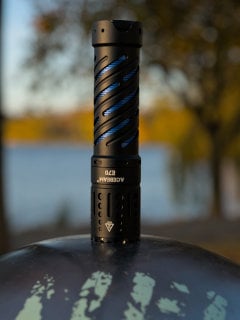So people throw out disposable vapes all the time. I cracked one open to take a look and it turns out they have a 18500 battery in it. So I was thinking of 3D printing a spacer to make it the same size as a 18650 and putting some shrink wrap on them. I just wanted to see what people who know more than me think. Is this a bad idea that is going to burn my house down? a waste of time perhaps?
I did a trial run in my wurkkos fc11 and they seem to work, it charges and looks just as bright.
Just be wary of them as they are likely unprotected cells.
Batteries made for flashlights will have a protection circuit board on it to protect against over & under voltage and sometimes overheating.
Unprotected batteries do not have a circuit board on them and are usually protected by the device that they are installed into.
You can use them BUT you have to be incredibly careful with them as if things go wrong you will be holding what has essentially become a small pipe bomb.
This is just not true. The circuitry is in the flashlight, not the battery.
There is usually basic over discharge protection in the flashlight circuitry and over charge protection for lights with on light charging.
This usually works in conjunction with the protection circuit on the batteries.
18650 batteries (and other sizes) have become more wide spread because of the increased safety of protected batteries.
The batteries OP wants to use are unprotected cells who’s manufacturer is unknown, actual capacity is questionable and how they have been handled is unknown.
As a rule of thumb flashlights only have LED driver in them and lack any sort of battery protection. Most 18650 batteries that you buy from reputable sources have built-in protection circuits. Cheap cells from ebay et al and recycled cells from old devices are a wildcard, they may or may not have the protection and you need to read the description very carefully or examine the cell in detail to see if it’s protected or not. IIRC, even most lithium cell chargers rely on the cell having built-in protection circuit.
I wouldn’t use unprotected cells for anything that I hold in my hand or put in my pocket/everyday carry. They’re literally marginally stable incendiary devices—I’d feel more safe with a block of C4 in my pocket than an unprotected lithium cell of questionable origin and history.
As a rule of thumb flashlights only have LED driver in them and lack any sort of battery protection.
This hasn’t been true for a quite a while. Most Li-ion flashlights have a low-voltage shutoff.
Most 18650 batteries that you buy from reputable sources have built-in protection circuits.
Also not really true. Top-tier dealers like Illumn and Nkon offer both protected and unprotected options. Some popular flashlights (Zebralight, Emisar/Noctigon) only accept unprotected cells.
even most lithium cell chargers rely on the cell having built-in protection circuit.
No charger anybody should be using relies on that. Correctly charging Li-ion requires tapering current after reaching the target voltage, which can’t happen if it trips a circuit breaker.
Maybe. Last time I was in market for a flashlight was 5 or so years ago. I don’t even have a use for handheld lights anymore.
I still won’t trust unprotected lithium cells for use in any device I carry on my person.
Really?
Is that why I can buy either protected or unprotected cells?
I just bought unprotected batteries for a project - I considered protected, but they were 2x+ the cost.
protected by the device that they are installed into.
So if I charge them using the flashlight would that have the protection built in?
No,
Lights designed for charging removable batteries will (usually) have charging circuit designed for protected batteries as they expect the battery to provide feedback on voltage, temps etc.
Random unprotected cells should be charged in an external charger in a fire resistant area and used extremely carefully in lights you don’t mind loosing.
The only thing I would recommend for you to do is send them in for recycling.
The protection circuit of a cylindrical Li-Ion battery doesn’t report anything. All it can do is to interrupt the circuit if the current gets too high or the voltage too low.
You might mix this up with tool batteries that usually have multiple cells in a series and in parallel, monitored by a battery management system (BMS).
Most quality flashlights have an integrated low voltage protection. The protection PCB will only protect the battery when it’s handled outside of the flashlight, but it will usually reduce the performance and efficiency due to the added resistance.
Agree with everying but the recycling.
With a proper charger (as you said, in a fire safe place), they can be used.
But… Also as you implied, don’t trust them to be safe on their own (like any unprotected battery).
I have some unprotected, they only get charged with an appropriate charger, and used in devices that are safe with unprotected cells.
Now, if someone doesn’t want to be bothered with managing unprotected cells, then yea, recycle them.
Most newer flashlights have over-discharge protection, and most flashlights with built-in charging terminate properly without overcharging cells. Both are true of the FC11, and its original battery is unprotected. It is a very popular flashlight, and I have never seen a post about a safety-related malfunction with one in any of the popular flashlight communities.
@dr_jekell@lemmy.world has a point that cells salvaged from random low-quality devices may be unsuitable for another application (or even their original application). There’s a chance that the current draw will be too high, or the charge rate too fast, for example. There’s also a chance that the cells will be poorly manufactured and/or lacking the basic safety devices that even unprotected cells normally have. I don’t recommend using them.
Rubbish. Many high performance flashlights won’t even work properly with protected cells, they need more amps and trip the protection. Unprotected cells are perfectly fine providing you use a proper charger and don’t short circuit them. That is assuming you use good quality cells, I would not trust what is in a disposable vape.
Should work fine. 18500 batteries have the same specifications as 18650s except for, of course, a smaller physical size and so a smaller capacity to go with it. Other than that, you should be able to treat them more or less identically to a normal 18650.
I’m a vaper and a flashlight enthusiast. Used up vape batteries are basically flaccid shadows of their former glory. You will get a dim glow for a few minutes and that shit will fail on you. Buy new cells for your vapes and your flashlights. Old cells are for recycling.
I’m not a flashlight or vape guy. Many cells have built in protection circuits. I always assume these are not present and make sure external protections are provided. Your idea should work, but usually smaller batteries mean smaller capacity, and sometimes lower current charging and discharging.
Do not solder directly to any battery. Have an explosive containment pie-dish nearby. Use under supervision the first few times.
I have a metal paint can, an ABC extinguisher and short term + long term disability insurance. I’m ready to do some stupid shit.
Hahahahaha, my kind of idiot (that is, I see myself in you)! 🤣
I would try to search around for a data sheet on that cell to verify its chemistry. For example, CR123 batteries are a lithium based chemistry (LiMnO2) but they’re not normally rechargeable. That doesn’t mean that some companies are putting out lithium ion batteries in that form factor labeled as the original cell type…
I’ve used those batteries to replace various 3xAlkaline appliances just fine. Should work for lithium flash lights. Of course with quiet a limited capacity.








